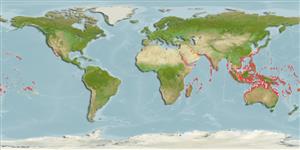>
Eupercaria/misc (Various families in series Eupercaria) >
Labridae (Wrasses) > Corinae
Etymology: Cheilio: Greek, chanos, -eos, ous, and chasma, -atos = abyss, mouth opened, inmensity + Latin, muraena = morey eel (Ref. 45335).
More on author: Forsskål.
Environment: milieu / climate zone / depth range / distribution range
Écologie
marin récifal; profondeur 1 - 30 m (Ref. 1602), usually 2 - 30 m (Ref. 27115). Tropical; 24°C - 27°C (Ref. 27115); 32°N - 36°S, 24°E - 109°W
Indo-Pacific: Red Sea and East Africa to the Hawaiian and Easter islands, north to southern Japan, south to Lord Howe Island.
Taille / Poids / Âge
Maturity: Lm ? range ? - ? cm
Max length : 50.0 cm SL mâle / non sexé; (Ref. 9823); common length : 35.0 cm TL mâle / non sexé; (Ref. 5450)
Description synthétique
Clés d'identification | Morphologie | Morphométrie
Épines dorsales (Total) : 9; Rayons mous dorsaux (Total) : 12 - 13; Épines anales: 3; Rayons mous anaux: 11 - 12. Young individuals are usually a mottled brown or green, sometimes with a broad lateral stripe (Ref. 1602). Rare individuals may be uniformly yellow (Ref. 1602). Coloration in this fish is variable: green, brown, orange-brown or yellow, often with narrow, midlateral, broken black stripe which are absent in large males (Ref. 86689). Large males may develop a bright yellow, orange, black, white, or multicolored patch on their sides behind their pectoral fins (Ref. 1602).
Inhabit seagrass beds and algal-covered flats, occasionally in lagoon and seaward reefs to a depth of at least 30 m (Ref. 1602, 41878, 48636). Benthopelagic (Ref. 58302). Usually solitary. Juveniles secretive in seagrasses or attached Sargassum; adults usually in small loose aggregations, but occasionally form large schools to spawn (Ref. 48636). Feed mainly on crustaceans, mollusks, sea urchins (Ref. 37816) and other hard-shelled prey. Oviparous, distinct pairing during breeding (Ref. 205).
Life cycle and mating behavior
Maturité | Reproduction | Frai | Œufs | Fécondité | Larves
Oviparous, distinct pairing during breeding (Ref. 205).
Randall, J.E., G.R. Allen and R.C. Steene, 1990. Fishes of the Great Barrier Reef and Coral Sea. University of Hawaii Press, Honolulu, Hawaii. 506 p. (Ref. 2334)
Statut dans la liste rouge de l'IUCN (Ref. 130435: Version 2024-1)
Menace pour l'homme
Reports of ciguatera poisoning (Ref. 130160)
Utilisations par l'homme
Pêcheries: intérêt commercial mineur; Aquarium: Commercial
Outils
Articles particuliers
Télécharger en XML
Sources Internet
Estimates based on models
Preferred temperature (Ref.
123201): 24.4 - 29, mean 27.7 °C (based on 1206 cells).
Phylogenetic diversity index (Ref.
82804): PD
50 = 1.0000 [Uniqueness, from 0.5 = low to 2.0 = high].
Bayesian length-weight: a=0.00407 (0.00249 - 0.00666), b=3.09 (2.95 - 3.23), in cm total length, based on LWR estimates for this species & (Sub)family-body (Ref.
93245).
Niveau trophique (Ref.
69278): 3.5 ±0.54 se; based on food items.
Résilience (Ref.
120179): Faible, temps minimum de doublement de population : 4,5 à 14 années (Preliminary K or Fecundity.).
Fishing Vulnerability (Ref.
59153): Moderate vulnerability (44 of 100).
Nutrients (Ref.
124155): Calcium = 43.3 [22.3, 72.7] mg/100g; Iron = 0.482 [0.278, 0.936] mg/100g; Protein = 18.1 [15.2, 20.3] %; Omega3 = 0.0782 [, ] g/100g; Selenium = 34.1 [18.2, 65.8] μg/100g; VitaminA = 92.6 [27.1, 350.8] μg/100g; Zinc = 1.33 [0.91, 2.07] mg/100g (wet weight);
